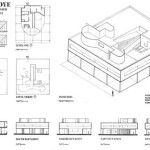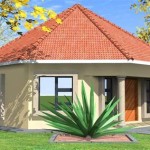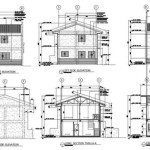5 Bedroom House Floor Plans in 3D: A Comprehensive Guide
Designing a 5-bedroom house is a significant undertaking, requiring careful consideration of space, functionality, and aesthetics. Utilizing 3D floor plans provides a powerful visualization tool, allowing homeowners and architects to explore different layouts, understand spatial relationships, and make informed decisions before construction begins. This article explores the key considerations when planning a 5-bedroom house, highlighting the benefits of 3D visualization and examining various floor plan options.
The demand for larger homes, particularly those with five bedrooms, is driven by various factors, including growing families, the desire for dedicated home offices, and the need for guest accommodations. A well-designed 5-bedroom house should not only accommodate these functional needs but also create a comfortable and inviting living environment. The effective use of space, natural light, and architectural details are crucial in achieving this balance.
Furthermore, with advancements in technology, 3D rendering has become an increasingly accessible and valuable tool for architectural design. It allows for a more immersive and realistic representation of the house, facilitating communication and collaboration between homeowners, architects, and builders. The ability to virtually walk through the house before it's built allows for identification and correction of potential design flaws early in the process, saving time and resources.
Understanding Space Allocation in a 5-Bedroom House
The cornerstone of any successful house design is efficient space allocation. When planning a 5-bedroom house, careful consideration must be given to the size and placement of each room. Bedrooms should be adequately sized to accommodate beds, storage, and personal space. The master suite typically receives more attention, often including a walk-in closet and en-suite bathroom. The remaining bedrooms can be designed to be more compact, catering to children or guests. The layout should also minimize noise transfer between bedrooms, particularly those close to living areas.
Beyond the bedrooms, the common areas – living room, dining room, and kitchen – must be thoughtfully integrated. Open-concept designs are popular, creating a sense of spaciousness and facilitating social interaction. However, it's important to define functional zones within the open area, using furniture placement and architectural elements to create distinct spaces. The kitchen typically serves as the hub of the home, requiring ample counter space, storage, and efficient workflow. A kitchen island can provide additional workspace and seating, while a pantry offers convenient storage for groceries and appliances.
Bathrooms are another critical aspect of space allocation. Ideally, a 5-bedroom house should have at least three bathrooms: one en-suite in the master bedroom, one shared by the other bedrooms upstairs, and a powder room on the main floor for guests. The size and layout of each bathroom should be tailored to its intended use. The master bathroom can be more luxurious, featuring a separate shower and bathtub, while the other bathrooms can be more functional and efficient. Proper ventilation is essential in all bathrooms to prevent moisture buildup and mold growth.
Finally, the overall footprint of the house must be considered in relation to the size of the lot. A larger house requires a larger lot, which may impact the amount of outdoor space available. It's important to balance the desire for a spacious interior with the need for outdoor living areas, such as a backyard, patio, or garden. Site orientation is also crucial, as it affects the amount of natural light and solar gain the house receives. A well-oriented house can reduce energy consumption and create a more comfortable living environment.
The Advantages of 3D Floor Plan Visualization
3D floor plans offer a significant advantage over traditional 2D drawings by providing a more realistic and immersive representation of the house. This allows homeowners to better understand the spatial relationships between rooms, visualize the flow of traffic, and identify potential design flaws before construction begins. With 3D visualization, it's possible to experiment with different layouts, furniture arrangements, and color schemes to find the optimal design for one’s needs and preferences.
One of the key benefits of 3D floor plans is the ability to assess the impact of natural light on the interior spaces. By simulating the sun's path throughout the day, 3D software can reveal how light will enter the house at different times of the year. This can inform decisions about window placement, room orientation, and the use of shading devices. Maximizing natural light can improve the overall ambiance of the house and reduce reliance on artificial lighting.
Furthermore, 3D floor plans facilitate better communication between homeowners, architects, and builders. The visual clarity of a 3D model can help to bridge the gap between technical drawings and the homeowner's vision. It allows for a more collaborative design process, where ideas can be easily shared and discussed. This can lead to a more satisfactory outcome, as the homeowner feels more involved and informed throughout the process.
Another advantage is the ability to experiment with different materials and finishes in a virtual environment. 3D software allows users to apply different textures, colors, and patterns to walls, floors, and ceilings. This can help to visualize the overall aesthetic of the house and ensure that the chosen materials complement each other. It also allows for cost comparisons, as different materials can be easily swapped out to assess their impact on the budget.
Modern 3D rendering software often includes features such as virtual reality (VR) integration. This allows users to experience the house in a fully immersive environment, using a VR headset. This can provide an even greater sense of realism and help to identify potential issues that might not be apparent in a traditional 3D model. VR walkthroughs can be particularly useful for complex designs, where it's difficult to visualize the spatial relationships in a 2D or 3D rendering.
Exploring Different 5-Bedroom Floor Plan Options
There are numerous ways to design a 5-bedroom house, each with its own advantages and disadvantages. The best floor plan for a particular family will depend on their specific needs, preferences, and lifestyle. Some common floor plan options include two-story designs, ranch-style houses, and split-level layouts. Each style offers unique characteristics in terms of space utilization, accessibility, and aesthetic appeal.
Two-story houses are a popular choice for 5-bedroom homes, as they maximize the use of land by stacking living spaces vertically. Typically, the bedrooms are located on the upper floor, providing privacy and separation from the main living areas on the ground floor. This layout can be particularly suitable for families with young children, as it allows for easy supervision of the bedrooms. However, two-story houses may require climbing stairs, which can be a concern for elderly or disabled individuals.
Ranch-style houses, also known as single-story houses, offer the advantage of accessibility, as all living spaces are located on a single level. This can be a great option for families with young children or elderly individuals. However, ranch-style houses typically require a larger lot, as the living spaces are spread out horizontally. This can also make it more difficult to achieve privacy, as the bedrooms may be located closer to the street or neighboring properties.
Split-level houses offer a compromise between two-story and ranch-style designs. They typically feature two or three levels, with short flights of stairs connecting each level. This layout can provide a good balance of privacy and accessibility, as the bedrooms can be located on a separate level from the main living areas, while still maintaining relatively easy access to all parts of the house. However, split-level houses can be more complex to design and build, and may not be suitable for all sites.
Within each of these styles, there are countless variations in terms of room layout, size, and orientation. Some popular features include open-concept living areas, master suites with walk-in closets and en-suite bathrooms, and dedicated home offices. The key is to carefully consider the family's specific needs and preferences, and to work with an architect or designer to create a floor plan that meets those needs effectively. The use of 3D floor plans can be invaluable in this process, as it allows for experimentation with different layouts and visualization of the final result.
In addition to the basic floor plan, it's also important to consider other factors such as storage space, natural light, and energy efficiency. Ample storage space is essential for keeping the house organized and clutter-free. Natural light can improve the overall ambiance of the house and reduce reliance on artificial lighting. And energy-efficient design can reduce utility bills and minimize the environmental impact.

5 Bedroom Bungalow Rf 5006 Floor Plans House Design Style

5 Bedroom House Plan Examples

Image Result For 5 Bedroom House Plans Zimbabwe Planos De Casas Modernas Pisos 3d

5 Bedroom House Plan Examples

Pin By Juthxmac On Interior Design 3d Plans 5 Bedroom House One Apartment Floor

5 Bedroom Apartment Plan Examples

3d Plans Vertex

5 Bedroom Bungalow Rf 5005 House Floor Plans Building

5 Bedroom House Plan Examples

Modern Two Y House Design 5 Bedroom Plan 3d Plandeluxe








